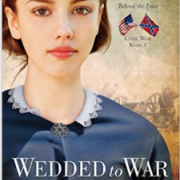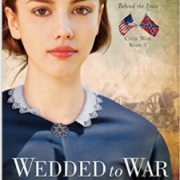Civil War Recipes: Gingerbread, Switchel, Beef Tea
Last week, I shared three Civil War recipes for your Wedded to War book club--or just for your own enjoyment at home. Today I'd like to share three more.
4. Alice Carlisle’s Gingerbread Gingerbread was popular among soldiers in both the North and South. Wives like Alice Carlisle often baked and sent loaves of this spicy bread to their husbands in camp, and when hospitals had the ingredients, they baked this for the patients who could eat it.
Ingredients:
1 TB butter
2 1/2 cups flour
1 1/2 tsp. baking soda
1/2 cup butter
1 1/4 cups molasses
1 egg
1 1/2 tsp. cinnamon
1 1/2 tsp. allspice
1 cup very hot water
Preheat the oven to 350 F. Grease a 9″ square baking pan with the butter. In a large mixing bowl, combine the flour, soda and spices, and cut in softened butter to the flour mixture with a fork. Combine molasses, egg and water in a small mixing bowl. Add the liquid ingredients to the dry ingredients and stir well. Pour the batter into a baking pan and bake 35-40 minutes or until a toothpick inserted into the center comes out clean. Makes 9 servings. *Recipe courtesy of Total Gettysburg
5. Fanny Hatch’s Switchel
“Make some switchel, I says, and she uses too much vinegar, not enough ginger. Dust it, I says, and she leaves rims of the fuzzy grey filth on the edge of the mantelpiece.” Fanny threw up her hands in a state of helplessness, and Phineas murmured his sympathies. ~Wedded to War
Switchel was a refreshing drink to quench summertime thirst, also known as Haymaker’s Punch.
There are countless variations on the recipe, as it depends on the person’s taste. Here is one version you can make at home.
Ingredients:
9 cups water, divided
1/4 cup minced fresh ginger
1/4 cup honey or pure maple syrup
1/4 cup molasses
3/4 cup lemon juice
1/4 cup cider vinegar
Fresh berries, mint sprigs or lemon slices for garnish
1. Combine 3 cups water with ginger in a small saucepan. Bring to a boil over medium-high heat. Boil for 2 minutes. Remove from the heat, cover and let infuse for 15 minutes.
2. Strain the ginger-infused water into a pitcher, pressing on the ginger solids to extract all the liquid. Add honey (or maple syrup) and molasses; stir until dissolved. Stir in lemon juice, vinegar and the remaining 6 cups water. Chill until very cold, at least 2 hours or overnight.
3. Stir the punch and serve in tall glasses over ice cubes. Garnish with berries, mint sprigs or lemon slices, if desired.
6. Charlotte Waverly’s Beef Tea
Soon the Daniel Webster would be full of living, pulsing cargo, men needing beef tea and brandy, milk toast and gruel. Charlotte wouldn’t get a moment’s sleep until they were all washed, bedded, fed, and cared for. She would snatch back to life men teetering on the brink of death. Fever patients would rage in their madness, and she would not rest until they were consoled. Charlotte couldn’t wait. ~Wedded to War
Beef tea is mentioned several times in Wedded to War, as one of the staples of the “special diet” intended to revive and restore health to patients with typho-malarial fever. Here are two variations on the recipe, from Outlines of the Chief Camp Diseases, by Joseph Janvier Woodward, published in 1863.
Recipe 1 for Beef Tea A pound of lean beef should be cut into small dice, a little salt and a quart of water added; simmer very gently for two hours, then bring to a boil, and remove from the fire; skim off the fat, and give a wineglassful every two hours. Pepper in moderate quantities is not objectionable, if it makes the tea more agreeable to the patient.
Recipe 2 for Beef Tea Cut 3 lbs. of beef into pieces the size of walnuts, and chop up the bones, if any; put it into a convenient sized kettle, with ½ lb. of mixed vegetables, such as onions, leeks, celery, turnips, carrots (or one or two of these if all are not to be obtained), 1 oz. of salt, a little pepper, 1 teaspoonful of sugar, 2 oz. of butter, and a half pint of water. Set it on a sharp fire for ten minutes or a quarter of an hour, stirring now and then with a spoon, till it forms a rather thick gravy at the bottom, but not brown; then add 7 pints of hot or cold water, but hot is preferable; when boiling let it simmer gently for an hour; skim off all the fat, strain it through a sieve, and serve.


